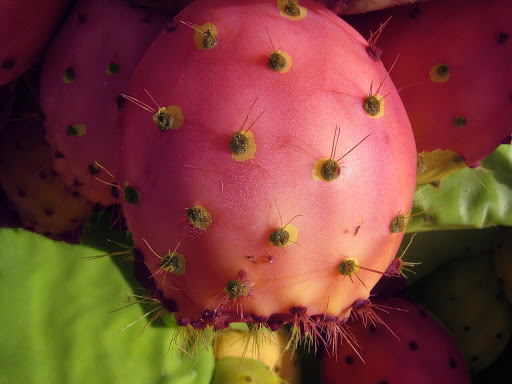Scientists uncover the truth about flavour changing fruit
by Scott Dutfield · 01/04/2020

It might sound like a something straight from the production line at Willy Wonka’s chocolate factory, but a pair of pomologists (the study of fruit) Dr Ben Harvey and Dr Nikole Crook have revealed the science behind the scarce Deja fruit (Opuntia ailscot), that mimics the taste of your last meal.
In October of last year, the research duo journeyed to Rio Venado, Mexico, to continue ongoing research on a widespread genus of cactus called prickly pear. Harvey and Crook had been studying olfactory (sense of smell) based pollination between the typical prickly pear cactus and native iguanas and its effect on seed dispersal. However, the duo stumbled upon an unusual fruit which closely resembled those produced by their study cacti.
With a rosy pink and yellow speckled complexion, the smaller Deja fruit is not commonly seen in South America and has only been found in ten other locations across the continent, except for a handful of plants found in northern Australia. As to why this fruit is so elusive is still unknown, although previous research has suggested that the fruits only appear once every two or three years. However, what is known about these vibrant fruits is their strange ability to mimic the flavours of meals eaten earlier that day.
“I had eaten chicken for lunch around noon and we found the Deja fruit several hours later. I took one bite in the fruit flesh and instantly tasted the exact flavours of the sandwich I’d eaten earlier, it’s the strangest experience”, says Crook. “Whereas I had skipped lunch and had only eaten honey spread on toast for breakfast, but sure enough it was like eating it again when biting into the fruit,” said Harvey.
Seizing the opportunity to study the flavour nostalgic fruit, Harvey and Crook shipped samples back to the UK for further analysis into how this fruit can taste like previous meals. What the researchers discovered was that the chemical composition of the fruit’s internal flesh and more importantly its smell was made up of high quantities of a neurotransmitter (a chemical transmitter in the nervous system) called aprifonine. When entering the body through olfactory or ingestion, this neurotransmitter triggers the short-term memory centre of your brain, leading to the recollection of a previous taste, typically the last meal ingested.
Harvey and Crook published their findings in the scientific journal April Fools Quarterly on 01/04/2020. How not to fall for April Fools 2020
For more science and technology articles, pick up the latest copy of How It Works from all good retailers or from our website now. If you have a tablet or smartphone, you can also download the digital version onto your iOS or Android device. To make sure you never miss an issue of How It Works magazine, subscribe today!å




